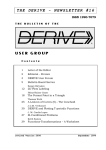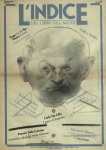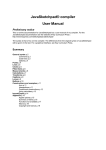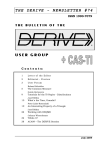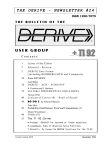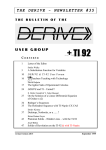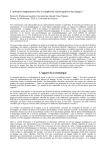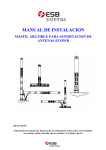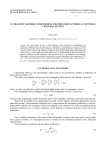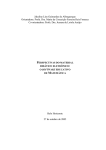Download THE DERIVE - NEWSLETTER #13 USER GROUP
Transcript
THE DERIVE - NEWSLETTER #13 ISSN 1990-7079 THE BULLETIN USER OF THE GROUP C o n t e n t s: 1 Letter of the Editor 2 Editorial - Preview 3 DERIVE User Forum 7 Bulletin Board Service 14 Thomas Weth A Lexicon of Curves (3) - The Trisektrix 20 David Sjöstrand CAS and Spreadsheets (MS Excel) 29 J.M.Cardia Lopes Minimization of a "Flat Function" 31 J. Wiesenbauer Titbits in Algebra and Numbertheory revised reprint 2007 March 1994 D-N-L#13 INFORMATION-Book Shelf D-N-L#13 [1] ANALYSIS, Bilder und Filme mit DERIVE, U.Keusen und H.-J. Kayser MBU 3/93.1, Bergmoser + Höller Verlag GmbH, Aachen [2] LINEARE ALGEBRA, Matrizen mit DERIVE, B.Barzel und P.Drijvers MBU 5/93.1, Bergmoser + Höller Verlag GmbH, Aachen [3] Ein elementarer Zugang zu Potenzreihen, W.Koepf Didaktik der Mathematik 21, 1993, 292 - 299, Bayerischer Schulbuchverlag [4] MATEMATICA I, Consorzio Nettuno, S.Cappuccio & G.C.Barozzi Pitagora Editrice Bologna Hosted by Valencia Community College, Sponsored by Adison-Wesley Publishing Company Founded by Franklin Demana and Bernd Waits, Conference Chair Judith Jones Walt Disney World Dolphin Hotel, Orlando Florida Mail or Fax to: Addison-Wesley Publishing Company, Attn: Beth Sheehan, 1 Jacob Way, Reading, MA 01867 Fax # 617-944-8964 W e h a v e a F A X n ow !! We h a ve a FAX now!! We have a FAX now!! O u r F A X n u mb er is our phone num ber : +43 (0)2275 8207 W e h a v e a F A X n ow !! We h a ve a FAX now!! We have a FAX now!! At this occasion a FAX number correction: Herbert Appel´s FAX number is ++(0)9264 8700 (Germany) Sorry Herbert for the mistake D-N-L#13 L E T T E R O F T H E E D I T O R p 1 Liebes DUG - Mitglied, Dear DUG Member, ich freue mich wirklich, Sie alle wieder in der DUG begrüßen zu dürfen. Bei dieser Gelegenheit möchte ich mich für die vielen lieben Briefe und für Ihre Anerkennung für unsere Arbeit recht herzlich bedanken. Eine kleine Auswahl finden Sie im User Forum. Verstehen Sie das bitte nicht als Eigenlob, denn Ihre Zustimmung gilt vor allem den recht zahlreichen DERIVIANERN, die immer wieder Anregungen und Beiträge liefern. Ein Blick auf die Themenvorschau läßt ein interessantes und reichhaltiges DNL-Jahr erwarten. Leider läßt es meine Zeit (noch) nicht zu, den Umfang des DNL zu erweitern. (Ich habe auch noch einen "Nebenberuf"!) I´m really glad to meet you all again in the DUG. I would like to take the opportunity to thank for all your nice letters and for your appreciation. You will find a little selection in the User Forum. Please don´t see this as self-praise, because your approval especially goes to the numerous DERIVIANS, who submit papers and give suggestions. One glance at the preview shows that we can expect an interesting and contentful DNL-year. I´m sorry to say that I don´t have time (not yet) to extend the content of the DNL (I have a "sideline", too!) Ich möchte besonders auf die zuletzt versprochenen Algebra- und Zahlentheoriebeiträge von Dr. Wiesenbauer hinweisen. Dr. Wiesenbauer hat erfreulicherweise sein Versprechen in diesem DNL bereits eingelöst. Ich kann keinen der vor uns liegenden Beiträge hervorheben, jeder ist für sich originell und einmalig. Die Auszüge aus dem BBS werden fortgesetzt. Ein paar Seiten Computerlisting (ca 60) liegen noch zur Auswertung bereit. Ich kann Ihnen einige interessante elektronische Diskussionen ankündigen. Vor einer Woche erhielt ich eine wunderschöne DERIVE-Animation aus Norwegen. Halvor Devold erzeugte eine Show "Kepler´s World System in 3-D" mit DERIVE und GRASP. Herzlichen Dank, lieber Halvor. Die Teilnehmer von Krems 93 werden sich gerne an Deine beeindruckende Demonstration erinnern. Da Du mir die Weitergabe freigestellt hast, werde ich Deine Show in die Jahresdiskette 1994 aufnehmen. Ich bin sicher, damit in Deinem Sinn zu handeln. Zum Schluß noch drei administrative Hinweise: Wir sind endlich mit einem FAX erreichbar (Siehe Informations). Sie erhalten mit dem nächsten DNL eine Quittung über Ihren Mitgliedsbeitrag 1994. Falls Sie den Jahresbeitrag noch nicht geleistet haben, dann benützen Sie bitte das beiliegende Erinnerungsschreiben. Danke im voraus. I want to draw your attention to Dr Wiesenbauer´s Algebra and Number Theory contributions promised in the last DNL. I´m very glad that Dr Wiesenbauer has fulfilled his promise. It is really impossible for me to particularly point out one or the other contribution in the next issues, each one of them is original and unique. The extracts from the BBS will be continued. Some pages of computer paper ( ≈ 60) are waiting to be evaluated, whether they could be of interest for you. I can promise some useful electronic discussions One week ago I received a wonderful DERIVE animation from Norway. Halvor Devold produced a show "Kepler´s World System in 3-D". Many thanks, dear Halvor. Participants of the Krems Conference 1993 will certainly remember your impressive demonstration. As you have given your permission to distribute the file I feel free to incorporate your show into the 1994 diskette at the end of the year. I´m sure to act in your sense. Thanks again. Three administrative notes at last: You can reach us by FAX now . If it does not work the first time, please give it another try. (See Informationpage) Togetherwith the next DNL you will receive a receipt about your membership fees for 1994. If you haven´t settled your dues for 1994, then please use the reminder. Thanks in advance. I am looking forward to the 4th DUG year with you Sincerely yours Ich freue mich auf ein DUG Jahr 4 mit Ihnen Ihr p 2 E D I T O R The DERIVE-NEWSLETTER is the Bulletin of the DERIVE User Group. It is published at least four times a year with a contents of 30 pages minimum. The goals of the D-N-L are to enable the exchange of experiences made with DERIVE as well as to create a group to discuss the possibilities of new methodical and didactical manners in teaching mathematics. Editor: Mag. Josef Böhm A-3042 Würmla D´Lust 1 Austria Phone/Fax: +43-(0)2275/8207 Preview: I A L D-N-L#13 Contributions: Please send all contributions to the Editor. Non-English speakers are encouraged to write their contributions in English to reinforce the international touch of the D-N-L. It must be said, though, that nonEnglish articles will be warmly welcomed nonetheless. Your contributions will be edited but not assessed. By submitting articles the author gives his permission for reprinting it in D-N-L. The more contributions you will send, the more lively and richer in contents the DERIVE Newsletter will be. (Contributions for the next issues): Fluid flow in DERIVE, Reuther a.o., BRA Applications in Electrical Engineering, Scheuermann, GER Stability od systems of ODEs, Kozubik, SLK Los desplazamientos en las finciones elementales, Ramos, ESP Algebraic Operations on Polynomials in DERIVE, Roanes, ESP Prime Iterating Number Generators, Wild, UK Graphic Integration, Probability Theory, Linear Programming, Böhm, AUS DERIVE in Austrian Schools, some examples, Lechner & Eisler, AUS Tilgung fremderregter Schwingungen, Klingen, GER, Der Fermat-Punkt im Dreieck, Geyer, GER Continued Fractions in DERIVE, Cordobá a.o., ESP Life Game,Turtle-Commands in DERIVE, Lechner, AUS Dreieck.MTH, Wadsack, AUS, and others At this position in the last DNL you could find my Christmas-tree. In the letter of the Editor I expressed my hopes that I wouldn´t have to draw a DERIVE Easter Bunny. But look, Mr Klingen from Bonn sent a letter containing a wonderful rabbit: ....Because you have wished an Easter Bunny in your last issue, here is one. It is built from 28 points with 5 parametric splines consisting each of 6 or 7 points. Impressum: Medieninhaber: DERIVE User Group, A-3042 Würmla, D´Lust 1, AUSTRIA Richtung: Fachzeitschrift Herausgeber: Mag.Josef Böhm Herstellung: Selbstverlag D-N-L#13 DERIVE - USER - FORUM p 3 Dott. Mariarosa Castelletti, Segrate, Italy I introduced the DERIVE User Group and the DERIVE Newsletter at a meeting of Milanese section of Mathesis. Mathesis, founded in ´30 years by Federigo Enriques (important Italian mathematician), is an association of Medium, High School & University Math teachers. Mathesis is present all over Italy through autonomous local sections. The activities of those sections are training, updating and co-ordination of the members. In most cases they rely upon University Institutions, for example, in Milan, that is my section, they rely upon Mathematics Faculty. The next issue of the Milanese section´s bulletin will advertise the existence of the DERIVE User Group. Many Mathesis members, other than me, either know or have heard about DERIVE and they would like to share knowledge and experiences. If possible, it might be interesting to present some of the DERIVE Newsletter contributions on the Mathesis Bulletin of Milan. Some of the members and, by myself, I would like to translate the articles into Italian to override the difficulties of English and German to many of the potential readers. While I am waiting for your reply, also if negative, I renew to you my appreciation for your work and hope to hear from you soon again. Yours sincerely DNL: Thanks for the flowers. You were the first, I tried my FAX. I hope it worked. I´m glad for your PR work in Italy. Here is another letter from Italy: Sebastiano Cappuccio, Forli, Italy "Progetto Nettuno" is a project of the Politecnico di Torino, Politecnico di Milano and Universitá di Napoli "Federico II" for a triennial course of "Informatica" (Computer Science) with TV lessons broadcasted by satellite. There are about 500 students in the Academic year 1993/94, all over Italy. Students can attend their lessons at home. There are 6 "centri di ascolto" with computers, library, tutors, where students can also see recorded lessons and sit for examinations. Lessons are also broadcasted by State TV (from 3:00 to 6:00 a.m.!) and students can use their own videorecorders. Users are not only students, but also teachers and technicians who want to refresh their memory. The course of Matematica 1 (Analysis) is held by Giulio Cesare Barozzi, (University of Bologna), the Italian guru for symbolic computation. The attending book is for exercises of Matematica 1 and the use of DERIVE is systematic. With my best regards S.C. PS. Congratulations for your nice, interesting news-letter. The Bulletin of the DERIVE User Group is one of my favourite readings. Thank you! DNL: Sebastiano´s letter was accompanied by the book mentioned above. Although I don´t speak Italian I was able to follow the ideas. You will find the title and publisher in the book shelf. Thank you very much, Sebastiano! H. Nieder, Hamburg, Germany Ich danke Ihnen für Ihren Einsatz für die DUG und die Zeitschrift DNL, die ich mit Gewinn lese. Nicht jedes Software-Produkt, das in Schulen eingesetzt werden kann, wird so unterstützt wie DERIVE. Wir bleiben DERIVE und DUG treu. OStD. R. Schorn, Kaufbeuren, Germany In the "Journal of Recreational Mathematics" (Volume 25, Number 2 - 1993) I found the following problem: 2052. A Coefficient Problem by Charles Ashbacher, Cedar Rapids, Iowa. On page 473 of the unsolved problems section of Index to Mathematical Problems: 1989-1984 by Stanley Rabinowitz, there is the problem: Menemui 5.2.1: Find the largest coefficient in the expansion of (1 + 2x + 3x2 + 4x3)20. p 4 DERIVE - USER - FORUM D-N-L#13 (Menemui is the abbreviation for Menemui Matematik published by the Malaysian Mathematical Society.) Ob diese Aufgabe "zu Fuß" gelöst werden kann? Mit DERIVE geht es in einer Zeile (allerdings wird MISC.MTH gebraucht) und hat bei mir mit DERIVE XM etwa 6,5 Minuten gedauert. Tatsächlich hatte ich die Lösung zunächst durch Expandieren, Speichern auf eine Datei und "Anschauen" gefunden. 1: "MISC.MTH loaded with LOAD UTILITY" 2: MAX(VECTOR(POLY_COEFF((1+2*x+3*x^2+4*x^3)^20,x,i),i,60)) 3: 88423110877597693745 4. " 387,2 sec on a 486/33MHz with DERIVE XM Is there anybody who knows how to solve this problem by reasoning? My first attempt was to EXPAND, to SAVE the expression and look for the largest coefficient. Derive 6 needs only 2 seconds (without loading the utility file). Paul Drijvers, Utrecht, Netherlands Can you draw this picture in DERIVE? (Do not look at the back! DNL: I did. And thanks, Paul for your nice tree: Dr.Wolfram Koepf, Berlin, Germany Josef Lechner wants a fifth argument of the ITERATES function to construct, e.g., the expression x0 ,F1 ( xo ) ,F2 ( F1 ( x0 ) ) ,F3 ( F2 ( F1 ( x0 ) ) ) ,... (Bulletin of the DERIVE User Group 12, page 4). I agree absolutely with this wish! However, I like to show, how one is able to solve the given problem with the current versions of DERIVE: recursively. The DERIVE function: GENERATE(list,k):= IF(k=1,[ELEMENT(list,1)],APPEND(GENERATE(list,k-1), [LIM(ELEMENT(list,k),x,ELEMENT(GENERATE(list,k-1),k-1))])) does the Job, required. If we declare F1,F2,F3 and F4 as functions of one variable, too, and define list:=[F1(x),F2(x),F3(x),F4(x)], then simplification of the expression GENERATE(list,DIMENSION(list)) leads to the result D-N-L#13 DERIVE - USER - FORUM p 5 If we declare, however F5, ..., F10 as functions of one variable, too, and redefine list := [F1(x),F2(x),F3(x),F4(x),F5(x),F6(x),F7(x),F8(x),F9(x),F10(x)], then simplification of GENERATE(list,DIMENSION(list)) leads to memory overflow: In each step the recursion invokes the previous value twice, which generates hyperexponential complexity, and hyperexponential memory requirements. This problem can be resolved using an auxiliary function. We redefine GENERATE by the statements GENERATE_AUX(list,k,aux):= APPEND(aux,[LIM(ELEMENT(list,k),x,ELEMENT(aux,k-1))]) GENERATE(list,k):= IF(k=1,[ELEMENT(list,1)],GENERATE_AUX(list,k,GENERATE(list,k-1))) and simplification of the expression GENERATE (list,DIMENSION(list)) leads to I checked, but in case of 10 nested functions the auxiliary version is not necessary now. See some examples: A.C. Robin, Colchester, England I note that my difficulty with defining the derivative of x^3, using Derive has provoked some interest. Dr Schumm´s solution using ´LIMIT´ in DNL#12 is a more satisfactory solution than the use of DCUBE(u,x) in DNL#11, as whilst this gave DCUBE(x+z,x) correctly it did not give DCUBE(x^2+3,x) as 3(x^2+3)^2 as, of course I wished. p 6 DERIVE - USER - FORUM D-N-L#13 I have another similar problem involving integrals, and the integrals I have been using often involve INT(ê ^(-1) * x^n,x,0,inf). This integral should simplify to n!, Derive does not do this simplification, but it does verify it, for actual values of n. What I wish to know is whether there is any way of teaching Derive how to do integrals with which it is not familiar (thinking of this one in particular), so that when it encounters it in a more complicated expression, it can be simplified correctly. PS.: Has anyone thought of having a DERIVE Bulletin Board in the UK? J.M.M.Cardia Lopes, Porto, Portugal I have tried to run DERIVE 2.03 at a HP 9000 750/33 workstation by means of SOFT-PC (a MS-DOS emulator for UNIX). DERIVE works but the first screen stays over the next screens. The same with the graphics generated by PLOT. It looks bad and is very deficient. Do you know how to solve this bug? Do you know anyone who has the same problem? K. Winkelhausen, Arch, Switzerland Ich wäre froh, wenn ich einen Ausdruck sämtlicher DERIVE-Anwender der Schweiz erhalten könnte, um einen regen Kontaktaustausch innerhalb des Landes vornehmen zu können. DNL: Lieber Herr Winkelhausen! Ich möchte grundsätzlich keine Adressen weiterleiten. Ich nehme aber an, daß Sie mit der Angabe Ihrer Anschrift einverstanden sind, so können sich alle Schweizer DERIVE-Anwender mit Ihnen in Verbindung setzen: Solothurnstr. 15, CH-3296, Arch. K. Herdt, Osnabrück, Germany Für die Einführung und Erläuterung der Darstellung von Funktionen in Polarkoordinaten finde ich es aus didaktischen Gründen sehr hilfreich, daß DERIVE auch hierbei eine (undokumentierte?!) Parameterdarstellung erlaubt. Bei der Einstellung des Darstellungsmodus "Polar" wird nämlich der erste Term des geordneten Paares [a(t),b(t)] als Parameterdarstellung des Leitstrahls/Radiusvektors r interpretiert, der zweite als Parameter-darstellung des Polarwinkels ϕ. So wird beispielsweise durch [t,1] eine unter dem Winkel 1 (rad!) vom Ursprung ausgehende Strecke dargestellt, deren Länge durch den Laufbereich des Parameters t gegeben ist. Demgegenüber wird [1,t] als Kreisbogenstück vom Radius 1 interpretiert und [t,t] natürlich als Spirale. Soll nun beispielsweise für die in Polarkoordinaten gegebene Funktion r = sin(2ϕ) eine Unterteilung des Definitionsbereichs [0,2π] in vier Teilintervalle erfolgen, so läßt sich dies erreichen durch: VECTOR([SIN(2(k*π/2+t)),k*π/2+t],k,0,3) anschließend Simplify und Plot, wobei der Parameter t jeweils von 0 bis π/2 laufen muß (einmalige Eingabe mit Ctrl-Enter abschließen). Sofern die Farbeinstellung für die Darstellung der Graphen auf Auto steht, werden nun die vier Teilabschnitte des "Vierblatts" in unterschiedlichen Farben dargestellt und die Zuordnung dieser Teile zu den Abschnitten des Definitionsbereichs läßt sich besser erkennen. DERIVE allows an – undocumented? – parameter form for functions in polar form. This is very helpful for introduction and explication of functions in polar form. Having set the coordinate system to polar the expression [a(t), b(t)] is interpreted as parameter form [r(t), ϕ(t)]. So [t, 1] is a segment of legth t which forms an angle of 1 rad with the x-axis. [1, t] is a part of the circumference of a circle with radius 1 and [t, t] is a spiral. Expression #1 gives a demonstration of a quadrifolium r = sin(2ϕ) (in polar form) which shows the four parts of the leave in different colours (Option > Display > Color > Automatically change color of new plots) and makes clear the assignment of these parts to the parts of the domain D-N-L#13 Selections from the DERIVE-BBS p 7 Weniger erfreulich sind die von Version zu Version vorgenommenen (undokumentierten !) kleineren Änderungen bei bereits vorhandenen Funktionen und Operatoren von DERIVE. Bis zur Version 2.58 wurde streng unterschieden zwischen den drei Objekten Vektor (= geordnete Liste von Elementen), einzeilige Matrix und einspaltige Matrix (vergl. auch Handbuch, Vers. 2, S.135 ff). Verständlicherweise ließ sich daher ein Vektor (im Unterschied zu den beiden anderen Objekten) nicht transponieren. Ab Version 2.59 läßt sich nun plötzlich auch ein Vektor transponieren und es entsteht eine einspaltige Matrix, die konsequenterweise bei erneutem Transponieren in eine einzeilige Matrix übergeht. Für r jeden vom Nullvektor verschiedenen Vektor v ergibt sich also die sicherlich nicht sonderlich befriedigende r r r Ungleichung: v − (vT ) T ≠ o . Da die Autoren von DERIVE auch mit einem bestimmten pädagogischen Anspruch angetreten sind, ist dies eigentlich bedauerlich. DNL: Answers to inquiries of Mr Herdt and Mr Lopes: In one of the later messages in the BBS I found the similar problem: Message 3374 From SOFT WAREHOUSE to KEITH WILLIAMS about TRANPOSE OPERATOR BUG Thank you for your fax letter dated December 24, 1993 concerning a problem with DERIVE's transpose operator. The problem arose because DERIVE version 2.59 improperly transposes ragged arrays. Ragged arrays are vectors of vectors not all having the same number of elements. The problem did not arise in earlier versions of DERIVE because those versions did not even attempt to transpose ragged arrays. The problem has been resolved and will be included in the next version of DERIVE. Please send me your mailing address and I will send you a complementary update as soon as it is available. Aloha, Al Rich, Soft Warehouse, Inc. I sent a FAX to SWHH in the evening and thanks modern times same night at 03:22 am I received an answer from Al Rich: In response to requests by users, beginning with version 2.59 DERIVE transposes a vector to an n by 1 column matrix. The transpose of an n by 1 column matrix is a n by 1 row matrix. Since a 1 by n row matrix is not equivalent to an n element vector they cannot be subtracted and their difference is not the zero vector. Perhaps DERIVE should transform the vector into a row matrix so the subtraction can occur. However, this is not valid if the vector has symbolic elements that couls themselves be replaced by vectors. The screen problem that occurs when running DERIVE under Soft-PC must be a bug in Soft-PC, not DERIVE. Apparently Soft-PC does not correctly emulate the screen services provided by the IBM-PC BIOS. I recommend Mr. Lopes contact the authors of Soft-PC to see if they can resolve the problem. Sicerely, Al Rich P 8 Selections from the DERIVE-BBS D-N-L#13 Message 2392: From SOFT WAREHOUSE to PUBLIC about L'HOPITAL'S RULE The Derive LIM function is quite powerful, but it is educational to implement your own function for computing limits using L'Hopital's rule particularly if you want the rule to be automatically repeated if necessary. Consequently, file LHOPITAL.MTH is an interactive lesson that helps teach recursive Derive programming. To take the lesson, begin with Transfer Load Derive LHOPITAL, then follow the directions on the screen. Note that the use of LIM within the definition in the file is merely to SUBSTITUTE the limit abscissa for the limit variable in the numerator and in the denominator, so it is not cheating by using the internal implementation of L'Hopital's rule. I recommend using DERIVE´s stepwise simplification feature. Josef D-N-L#13 Selections from the DERIVE-BBS p 9 Message 2397: From SOFT WAREHOUSE to PUBLIC about MOCK CHAOS When plotted using the default range -pi < t < pi, the following elementary expression closely mimics the usual phase plot of the chaotic Lorenz strange attractor!: [ATAN (t) + t SIN (t^3), ATAN (t) + COS (t^3)] Message 2399: From SOFT WAREHOUSE to PUBLIC about A DERIVE DATA-BASE PROGRAM File DATABASE.MTH implements a simple data base program and gives examples of its use. "File DataBase.MTH: Example of data-base table look-up:" "1st establish some unassigned multi-character vars even in character mode:" age:= height:= eye_color:= brown:= blue:= "Establish some data records:" darth_vader:=[[age,84],[weight,240]] veronica:=[[age,30],[weight,130],[eye_color,brown]] "GET_AUX decrements k until it is 0 or the key is found:" "Note how we must use 3-valued logic (true,false,unknown) because Derive" "usually can't determine if two distinct nonnumeric keys are identically" "equal as math vars or never equal as math vars." "For example, the equation 'age=weight' could be identically true, or never true." GET_AUX(rec,key,k):=IF(k=0,?,IF(key=ELEMENT(rec,k,1),ELEMENT(rec,k,2),G GET_AUX(rec,key,k-1),GET_AUX(rec,key,k-1))) "Use Manage Substitute to replace d with the appropriate subexpression" " so that the subsequent two test cases simplify to 'brown' and '?':" GET(rec,key):=GET_AUX(rec,key,d) GET(veronica,eye_color) GET(darth_vader,eye_color) I tried d = 3: P10 Selections from the DERIVE-BBS D-N-L#13 Message 2538: From WILLIAMSON to SOFT WAREHOUSE about #2399 / DATABASE.MTH COMMENTS The instructions with DATABASE.MTH could be clearer. It should be pointed out that the k parameter in GET_AUX represents the number of fields in a record that can contain an undetermined number of fields. Dennis Message 2583: From SOFT WAREHOUSE to PUBLIC about MATRIX KRONECKER File KRONPROD.MTH contains a function that returns the Kronecker Product of two matrices. NCOLS(a)≔DIM(a↓1) KRON_PROD_AUX(a,b,m,n,p,q)≔VECTOR(VECTOR(a↓(1+FLOOR(i,p))↓(1+ FLOOR(j,q))b↓(1+MOD(i,p))↓(1+MOD(j,q)),j,0,n·q-1),i,0,m·p-1) KRON_PROD(a,b) ≔ KRON_PROD_AUX(a,b,DIM(a),NCOLS(a),DIM(b),NCOLS(b)) See one example: A short explanation for those (few) of you who – like me – don´t know the definition of the Kronecker product of two matrices: all elements of m2 are multiplied by the elements of m1 and these products replace the elements of m1. The black rectangle is the product of 2 and m2 and the red one is the product of 7 and m2. (Definition found in the fine book of Karsten Schmidt & Götz Trenkler, Einführung in die Moderne Matrix Algebra, Springer.) Message 2607: From SOFT WAREHOUSE to PUBLIC about SORTING File SORT.MTH is an interactive lesson that helps teach recursive Derive programming. The goal is a function that sorts a vector of rational numbers into nondescending order. To take the lesson, begin with Transfer Load Derive SORT, then follow the directions on the screen. Your rewards will be a greater problem-solving ability and a useful function to add to your personal utility library. I renamed SORT.MTH to SORT_.MTH and the function SORT to SORT_, because SORT has been implemented into DERIVE since long. Josef "File SORT_.MTH" "Selection-sort elements of numeric vector v into nondescending order." "Find minimum element of v from element k, with element m min so far:" FIND_MIN(v,k,m):=IF(k>DIM (v),m,IF(ELEMENT(v,k)<ELEMENT(v,m), FIND_MIN(v,k+1,k),FIND_MIN(v,k+1,m))) D-N-L#13 Selections from the DERIVE-BBS p11 "Sort elements of v into nondescending order from element i on:" SORT_AUX(v,i):=IF(i>=DIM (v),v,~ SORT_AUX(SWAP_ELEMENTS(v,i,FIND_MIN(v,i,i)),i+1)) SORT_(v):= "Define SORT_(v), then test & debug it on the following examples:" SORT_([]) SORT_([42]) SORT_([5,-2,1/2,3]) Solution and check using built-in SORT-function: Message 2699: From JERRY GLYNN to PUBLIC about OFFICIAL BUG REPORT FLOOR, MOD and IF functions do not work correctly in Derive with Limits. This is a known problem to Al and Dave who write the program but they do not have a fix for it in hand. Hopefully in time they will work it out. For now do not trust it. Message 2822: From HARALD LANG to PUBLIC about DERIVE AND EDUCATION There seems to be a discussion going on between Gary Ingram and Jerry Glynn, of which only parts are readable for the "public", so maybe I haven't got the issue properly. I don't quite see why DERIVE should be viewed as a pedagogical tool only. I teach mathematics at the Royal Institute of Technology in Stockholm, but I use DERIVE there only to prepare examples and exams, but I also do research in economics at Stockholm University, and there I use DERIVE also for my research. To me, DERIVE is a MATHEMATICAL ASSISTANT, i.e., I don't use it for anything I couldn't in principle do on paper myself, but if I instruct my assistant, it does it much faster and with fewer (hopefully, no) errors. It is like a pocket calculator: it is useful both in education and research. To me, a useful upgrade should contain better and more efficient algorithms, and I agree with Gary Ingram that the latest upgrade was a bit thin in that respect. For instance, one thing that has irritated me is that if I solve a problem and DERIVE is unable to simplify the answer, I don't get any answer at all. To fix the ideas, consider solving x from the equation ax + b = c. If a, b and c are messy expressions, then DERIVE tries to simplify the answer x = (c-b)/a by cancelling common factors in the denominator and numerator. This can easily be too complicated for DERIVE (which is natural), and then we don't get any answer at all! It would be much better if DERIVE automatically gave up a simplification if it is too complicated, and performed a less ambitious simplification (e.g., in the example, simplifying the numerator and denominator separately, without trying to find common factors). Maybe this is the reason why MAPLE -- according to Gary I, I don't have any experience of MAPLE -- is capable of solving more "advanced" equations? ---- Harald Lang P12 Selections from the DERIVE-BBS D-N-L#13 Message 2848: From HEINZ to PUBLIC about IN DEFENSE OF DERIVE I rise to speak in defense and in praise of DERIVE. I belong to that silent minority of DERIVE users who are not professional mathematicians. We were born genetically deficient in math talent but with a superabundance of appreciation for the beauty and power of mathematics and a burning desire to solve math problems, simply for the joy of seeing math formulas and symbols come alive in two and three dimensional graphs. DERIVE, like no other program, has done that for me and for that I am very grateful. I am also grateful for the many excellent books that were published exploring and explaining DERIVE. Each one of these books (seven of them) opened up new insights into the power and and enjoyment of math and DERIVE. I am not completely ignorant of math. I have a PH.D. in organic chemistry and some sixty publications in the fields of metallo-organic complexes, catalysis and coal chemistry. But,I am 82 years old, retired and don't have time to learn the language necessary to run MAPLE. I also have MathCad and like it very much, but if I want to take a quick look at the graph of a polynomial or do some symbolic linear algebra I turn to DERIVE. Let those who need a more sophisticated program use MAPLE, but don't spoil for us, less gifted mathematically, the joy of using DERIVE. Heinz Message 2860: From JERRY GLYNN to PUBLIC about WEB FUNCTION On my recent trip to Seattle to the National Council of Teachers of Mathematics Meeting I had a chance to visit Janet Ray and Mike Pepe at Seattle Central Comm. College. They are long time users of Derive and most other good math software. Janet and I had discussed how to use Derive to plot some functions in Derive using the iterates command and this lead to discussions with Mike (this was about 15 months ago) and on this visit I saw the result of this work. It represents to me the best example of the use of Derive in a graphical manner. I strongly suggest that you try this out and let all of us know what you find. f(x):= tri(x):=[[x,x],[x,f(x)],[f(x),f(x)]] next(m):=tri(element(m,3,1)) web(a,n):=iterates(next(m),m,tri(a),n) f(x):=2.6x(1-x) web(.3,5) approXimate the last line. Open a 2D graphing window and do Option State Connected and plot the result from approXimating web(.3,5). You also should plot x and f(x) to see the full effect. I set up a list [f(x),x,web(.3,5)] and graph it to get all 3 at once. In the function where I used 2.6 try 3.5 or 2.1 and see the differences that emerge. As you get a feel for the situation and the time it takes your machine to do the calculations increase the second arguement of web. On my 486 with Derivexm I run 50 or 100 quite easily. Now you can immediately plot web(.3,5) now without approximating but activate the Option Approximate Before plotting in the 2D-Plot Window. Message 2885: From WKSARTORY to PUBLIC about COMMANDS BY FILE I am interested in issuing commands (such as SIMPLIFY) by putting them in a .MTH file (or some other input file) rather than issuing them directly through the command line interface. Is there any reference that explains how this can be done? <<< Reply - see message #2980 >>> Message 2971: From SOFT WAREHOUSE to PUBLIC about DERIVE MEMORY USAGE There has been some discussion recently on this BBS concerning memory usage by the conventional memory version of DERIVE. It is a complicated subject but for those that are interested perhaps I can shed some light on it: DERIVE is written in muLISP-90, which in turn is written in 8086 assembly language. The 8086 microprocessor is a nightmare for implementing pointer-based languages like LISP. The 20 bit (one megabyte) address space is segmented into small 64K segments and only 4 segment registers are available. D-N-L#13 Selections from the DERIVE-BBS p13 The following summarizes how much memory is available for each of the various DERIVE data structures: Segments 1 2 2 1 1 1 2 --10 Kilobytes 64K 128K 128K 64K 64K 64K 128K ----640K Data Structure muLISP machine code and compiled DERIVE code DERIVE code stored as muLISP pseudo-code Mathematical expression storage Symbols and number storage ASCII strings for symbols Binary value for numbers Control and variable stacks TOTAL Note that the space allocated to the first two structures above is fixed. Space is dynamically allocated for the remaining structures on a demand basis. The space allocated to these structures can be less than the maximums listed above. If while running DERIVE, the space required for any one of these structures exceeds the above limits, a "Memory Full" error message occurs. Message 2972: From SOFT WAREHOUSE to PUBLIC about DOMAIN DECLARATION SYNTAX Currently DERIVE provides no way to declare variable domains from the Author line or in MTH files. A number of users on and off this BBS have requested this capability. The following examples shows the syntax I am considering for domain declarations for the next version of DERIVE: x x x x x Declaration :R :I :C :R (-5, 10] :I [0, inf) x x x x x Meaning is a real is an integer is a complex is a real in the half-open interval (-5, 10] is an integer in the infinite interval [0, inf) Note the similarity of the above with the current syntax used to assign variable values: x := x := 7 x is an unassigned variable x is a variable assigned the value 7 I would appreciate comments from BBS users about this proposed syntax for domain declarations. Message 2980: From SOFT WAREHOUSE to WKSARTORY about #2885 / AUTO-SIMPLIFICATION The following undocumented feature of DERIVE is relevant to your question: The Transfer Load Derive and Transfer Merge commands prompt the user to enter the name of a file to load. After typing the file name if you press Ctrl-Enter or Ctrl-J instead of Enter, each expression in the file is simplified as it is read in. Note this is analogous to the way Ctrl-Enter and Ctrl-J simplify expressions entered on the Author line (see Section 3.2 of the DERIVE User Manual). Remember, you heard it here first on the DERIVE BBS! Aloha, Al Rich, Soft Warehouse, Inc. Message 2993: From JERRY GLYNN to PUBLIC about USE OF COMPUTERS TO TEACH I recently returned from a regional meeting,in Winnipeg, Canada,of teachers of mathematics. I was struck by the fact that we now have decent computers and quite good software in our society but not much discussion about how to use this stuff to teach. Does anyone else see this? If you do and will says so maybe we can start a discussion about how to use computers to teach math. P14 D-N-L#13 Thomas Weth: A Lexicon of Curves (3) Ebene Algebraische und Transzendente Kurven (3) Thomas Weth, Würzburg, Germany Die Trisektrix von Maclaurin Maclaurin´s Trisectrix In der ersten Folge des DERIVE-Kurvenlexikons wurde die Kissoide vorgestellt. Sie diente zur Verdoppelung des Würfels. Neben der Würfelverdoppelung war die Dreiteilung eines beliebigen Winkels ein weiteres "klassisches" Problem. Im Laufe der Zeit beschäftigten sich ungezählte Mathematiker und Laien damit, die Winkeldrittelung mit Zirkel und Lineal zu lösen. Mit den Methoden der Algebra kann mittlerweile leicht gezeigt werden (vgl. Kunz), daß sich mit Zirkel und Lineal alleine ein beliebiger Winkel nicht in drei kongruente Teile zerlegen läßt. Trotzdem gingen und gehen immer noch Vorschläge von Laien an den Universitäten ein, die dieses Problem scheinbar elementar mit Zirkel und Lineal gelöst haben. Unter diesen Vorschlägen fanden sich mitunter so komplizierte und genaue Näherungslösungen, daß 1983 Dudley ein "Handbuch" für die gepeinigten Überprüfer derartiger Beweise unter dem Titel "What to do, when the trisector comes" herausgab. In Unter den nichtelementaren Lösungen der Winkeldreiteilung (also denen, welche außer Zirkel und Lineal andere Hilfsmittel verwenden) finden sich viele, welche algebraische Kurven zu Hilfe nehmen. Eine der bekanntesten ist die Kurve, die von Maclaurin erfunden wurde. Der Schotte Colin Maclaurin (1698-1746) wurde mit 19 Jahren Professor für Mathematik in Aberdeen, ab 1726 in Edinburgh. In seinem wichtigsten Werk "A treatise of fluxions" (1742) findet sich u.a. die nach ihm benannte Reihe sowie das gewöhnlich Cauchy zugeschriebene Integralkriterium für die Konvergenz unendlicher Reihen. Auf der nächsten Seite können Sie die GeoGebraKonstruktion sehen. Außerdem habe ich die Trisektrix mit DERIVE und den Schiebereglern nach der Konstruktionsvorschrift hergestellt. Mit dem Schieberegler für a verändert man die Größe der Schlinge und der Schieberegler für p lässt den Punkt P auf der Ortslinie wandern. the first part of the DERIVE - lexicon of curves the Cissoid has been introduced. This curve was used for doubling a die. Beside doubling a die dividing an arbitrary angle into three equal parts trisection - was another "classic" problem. During the centuries innumerable mathematicians have been busy to solve trisection of an angle using only ruler and compasses. By methods of algebra easily can be shown, that this is impossible. Nevertheless there are ideas from nonprof mathematicians how to solve the problem. There were so many very complicated ideas and constructions that in 1983 Dudley published a manual for the examiners "What do do, when trisector comes". Among the nonelementar solutions (using other tools beside ruler and compasses) you can find a lot which are using algebraic curves. One of the best known is the curve discovered by the Scot Maclaurin (1698 - 1746, professor for mathematics in Aberdeen with age 19, since 1726 in Edinburgh). In his most important opus "A treatise of fluxions" (1742) is to be found the socalled Maclaurin series, and the integral criterion for the convergence of infinite series (which is usually named after Cauchy!) y P r O 2a S x Given are the two points S and O with SO = 2a. Two rays are rotating round S and O with a start position OS in the x-axis. The ray round S is rotating three times faster than the other one. The intersection P is one point of the curve wanted and φ = ∠POS = 3 ψ with ψ = ∠PS and x-axis. The graphic is a Cabri-Geometre plot. D-N-L#13 Thomas Weth: A Lexicon of Curves (3) p15 Konstruktion der Kurve Gegeben sind zwei Punkte S und O mit der Entfernung 2a. Um S und O drehen sich zwei Strahlen, beide mit gleichem Drehsinn und beginnend aus der Ruhelage auf der Geraden OS. Der Strahl um S dreht sich dabei dreimal so schnell wie der Strahl um O. Die Schnittpunkte dieser Strahlen bilden die Trisektrix von MacLaurin, d.h. φ=3ψ. (Obiges Bild wurde mit Cabri-Geometre mit Hilfe der Ortslinienfunktion erstellt.) The left figure shows the GeoGebra-construction of the Trisectrix and the right one is the DERIVE construction running parallel to the analytic derivation of the equation using slider bars for a and parameter p. How to trisect an angle with the trisectrix The angle φ to be divided into three equal parts is drawn with its vertex in S and one ray on the xaxis. The other ray then intersects the trisectrix in P. ∠SOP then is the third of the given angle φ. Die Winkeldrittelung mit Hilfe der Trisektrix Zunächst zeichnet man eine Trisektrix (z.B. nach obiger punktweiser Konstruktion). Der zu drittelnde Winkel wird sodann mit dem Scheitel in S an der x-Achse angetragen. Der freie Schenkel des Winkels schneidet die Trisektrix im Punkt P. Der Winkel ∠SOP ist dann das gesuchte Drittel des ursprünglichen Winkels. Herleitung der Kurvengleichung Zur Herleitung der Kurvengleichung betrachtet man ∆OSP. Da φ Außenwinkel von ∆OSP ist und φ=3ψ, gilt ∠SPO = 2ψ. Nach dem Sinussatz gilt also in ∆OSP: (Sine rule!) r 2a = sin ψ sin 2ψ = sin ψ 2 sin ψ cos ψ , also r= a cos ψ = a cos φ 3 Ersetzt man r durch ρ gemäß ρ sin ψ = r sin 3 ψ (Sinussatz; Sine rule) und berücksichtigt, dass a 3 (3sinψ - 4sin ψ ) , also sin 3ψ = 3 sin ψ - 4 sin ψ , so erhält man: ρ sinψ = cos ψ a a 2 2 ρ= (3 - 4 sin ψ ) = ( 4 cos ψ - 1) cos ψ cos ψ Damit erhält man die Polargleichung mit S als Pol (die in Formelsammlungen übliche Darstellung): a ρ = 4a cos ψ . cos ψ p16 D-N-L#13 Thomas Weth: A Lexicon of Curves (3) Wählt man S als Ursprung eines kartesischen Koordinatensystems (s. Zeichnung) so folgt mit x x 2 2 ρ= x + y = die algebraische Gleichung für die und cos ψ = 2 2 ρ x + y Koordinaten des Kurvenpunktes P(x,y): 2 2 x +y = 2 4a x 2 x +y −a 2 x +y x 2 , also ..... 2 2 DERIVE: y (a + x) − x (3a − x) = 0 Damit ist die Trisektrix von MacLaurin eine algebraische Kurve dritter Ordnung. Mit DERIVE lassen sich nun aus den Kurvengleichungen - durch Auflösen der algebraischen Kurvengleichung nach y eine Parameterdarstellung der Kurve gewinnen (PLOT-Befehl!) oder eine andere Parameterform finden - die Asymptotik der Kurve untersuchen (x = -a) - Nullstellen berechnen ((0/0) und (3a/0)) - mit Hilfe von S = 1 2 2 r dϕ der von der Trisektrix eingeschlossene Flächeninhalt berechnen (S = 3a 3) 2 ∫ Supported by DERIVE you may gain the parametric form of the curve (solve the equation for y) or find another one investigate the asymptote (x = a) find the zeros ((0/0) and (3a/0)) calculate the area enclosed by the curve. A DERIVE-Trisectrix-Session Expressions #1 through #8 are accompanied by a plot with slider bars for p and a. This is another fine parameter form for the trisectrix. Now let´s derive the analytic form by eliminating parameter t. D-N-L#13 Thomas Weth: A Lexicon of Curves (3) Substitute for t in the second component of expression #11: and with little manipulation you can find the algebraic form. p17 p18 Thomas Weth: A Lexicon of Curves (3) Kurzreferenz für DERIVE User: D-N-L#13 Die Trisektrix von Maclaurin VECTOR(4*a*COS(phi)-a/COS(phi),a,0.5,2.5,0.5) Polar form: Parameter form: Algebraic form: r=4*a*COS(phi)-a/COS(phi) [x,-x*SQRT(3a-x)/SQRT(x+a)] y^2*(a+x)-x^2*(3*a-x)=0 Ausblick: In der nächsten Folge des DERIVE-KurvenLexikons werden einige Konstruktionen vorgestellt, mit welchen die bisher vorgestellten Kurven einheitlich erzeugt werden können. Besondere Beachtung werden dabei einige Konstruktionen erfahren, die erst in den letzten Jahren unter Mithilfe der Computerprogramme DERIVE und CabriGeometre entdeckt wurden. Outlook: In the next part some constructions will be shown, which enable to produce the curves introduced till now in a homogenous way. We will give special attention to those constructions which have been found out in the last years with help of computerprograms as DERIVE and CabriGeometre. D-N-L#13 Thomas Weth: A Lexicon of Curves (3) p19 On page 19 you can find the handheld derivation of the parameter form (which looks different as the others which have been found until now) and the implicit form. The next screen shots show parameter and polar form representations and the TI-Cabri-produced trisectrix. Literatur Bieberbach Baptist, P. Dudley, U. Kunz Theorie der geometrischen Konstruktionen, Birkhäuser, Basel, 1952 Winkeldreiteilung und Trisektierer, Praxis der Mathematik 29 (1987) Nr. 1, S. 43-50 What to do when the trisector comes, Mathematical Intelligencer, 5, 1, 1983 Algebra, vieweg, 1991 Another problem: (Dr. Weth) m Given is the set M = − n n 2 | ( m,n ) ∈ C m of 2 x 2 matrices. Wanted are all solutions of X2 + 1 = 0 (with 1 = the 2 x 2 identity matrix). All my attempts to solve this equation with DERIVE failed. Also failed the attempt to solve the equivalent equation X + X-1 = 0. i cos α ± sin α i cos α ± i sin α Calculating by hand I found solutions: und m sin α −i cos α ± i sin α − i cos α Maybe there is anybody among the DERIVE Users and - specialists all over the world who knows the solution. Many thanks for your help. p 20 David Sjöstrand: CAS and Spreadsheets D-N-L#13 Computer Algebra and Spreadsheets (e.g. Excel) David Sjöstrand, Onsala, Sweden In this paper we present some examples of how to use expressions, generated with a computer algebra system, DERIVE, in a spreadsheet program, MS Excel. These examples will appear in a coming book, Mathematics with Excel, (Studentlitteratur, Sweden). 1. Systems of linear equations The system of linear equations a1 x + b1 y + c1 z = d1 a2 x + b2 y + c2 z = d 2 a x + b y + c z = d 3 3 3 3 can easily be solved in DERIVE. The solutions will be expressions in a1, a2, ..., d3, which is suitable if you take into account that A1, A2, ... and so on are cell references in a spreadsheet. Steps to be taken in DERIVE DERIVE should be in Word Input Mode. This can be achieved via Options > Mode Settings > Input. Edit the expression [a1*x + b1*y+c1*z=d1,a2*x + b2*y+c2*z=d2,a3*x + b3*y+c3*z=d3] A system of linear equations is a vector of equations. Solve the system using the Solve-button (Looking Glass in the menu bar, highlight x, y and z.). The solution is given as a vector (list). Take care that the formulae for x, y and z will be separate expressions. You can do in the following way: D-N-L#13 David Sjöstrand: CAS and Spreadsheets p21 The expressions for x, y and z can be saved in BASIC-format and then be used in a spreadsheet. Save the formulae under the name LINEQU.BAS. (File > Write > Basic file) Steps to be taken in MS Excel (a) Open the file LINEQU.BAS. Cells A1, A3 and A5 should now contain the expressions for x, y and z as strings. (b) Move these expressions to the cells B7, B8 and B9 resepctively and remove the x, y and z but leave the = -sign to declare the expressions as formulae. (c) If we now, for example want to solve the system x + 16 y + 3z = 6 9x − 9 y + 2z = 4 21x + 12 y − 35 z = −2 we have to enter the coefficients in the range A1:D3. (d) You should find the result in cells B7:B9 in decimal form. If you would like to have the result in exact form (as fractions) then reformat cells B7:B9 using the respective dialogue box: p22 (e) David Sjöstrand: CAS and Spreadsheets D-N-L#13 The solution is: If you vary the entries in range A1:D3 then you can solve every non singular system of linear equations consisting of three equations with 3 unknown. 2. The circumcircle of a given triangle Let (x1, y1), (x2, y2) and (x3, y3) be three given points in the plane. Let (xM, yM) the center of the circumscribed circle of the triangle defined by the given points. xM and yM can be regarded as functions of the 6 variables x1, y1, x2, y2, x3 and y3. Steps to be taken in DERIVE In DERIVE we can derive the expressions for xM and yM. As the three vertices of the triangle have equal distances to point (xM, yM) we see that we can get the desired position if we solve the following system of equations, which is in fact linear in xM and yM. Use SOLVE or SOLUTIONS to solve the system with respect to xM and yM. You will receive two bulky expressions for xM and yM. If you apply the EXPAND command on the numerator and denominator, they will look like this: D-N-L#13 David Sjöstrand: CAS and Spreadsheets p23 Select (Highlight) expressions #18 and #19 and save them in BASIC format under the name, say CIRCUMS.BAS. Steps to be taken in MS Excel Open the file CIRCUMS.BAS. Cells A1 and A3 are containing the expressions for xM and yM as strings. These strings can again easily be converted to an MS Excel formula simply by removing the “xm” and “ym”. Then you will receive an error message, because you have nothing but empty cells in the range X1 : Y3. Now you can … Create a worksheet to plot a triangle with given vertices together with its circumcircle. 1. Move the expression for yM to cell B3 and the expression for xM to cell A3. You can drag with the mouse or use the commands Edit Cut and Edit Paste. Enter xM and yM in the cells A2 and B2 respectively. 2. Plot a triangle with vertices (3,1), (9,4) and (2,6). Enter the coordinates in the range X1 : Y3 and the formula =X1 and =Y1 in the cells X4 and Y4 (to close the triangle, similar as in DERIVE). Then move the contents of range X1:Y4 to the range C2 : D5 by again applying Cut and Paste. Select the range C2 : D5 and plot the triangle as a (XY)-diagram. 3. We plot the circle as another (XY)-diagram and have to provide the points forming the circumference. The points will be defined by the parameter representation of the circle. The equation of the circle is: x = xM + R cost with R = (x1 − xM ) 2 + (y1 − yM ) 2 y = yM + R sin t Enter R in cell 7 and the formula =SQRT((C2-A3)^2+(D2-B3)^2) in cell C8. (The German version of MS Excel needs WURZEL(…) instead of SQRT.) Enter Circumscribed Circle in cell A10 and t, x and y in the cells A11, B11 and C11 respectively. Then enter 0 in cell A12 and the formula = PI()/50+A12 in cell A13 and copy it to the range A13 : A112 (= 2π). Then enter the formulae =$A$3+$C$8*COS(A12) and =$B$3+$C$8*SIN(A12) in cells B12 and C12 respectively. Copy the contents of B12 : C12 to the range B112 : C112 and select range B12 : C112. Move the cursor – with the Ctrl-key pressed – to the top right corner of the selected range. The cursor changes to a little “+”. Now you can drag the table into your diagram and add the points of the circle. If you change any of the coordinates then the triangle and subsequently the circle will change accordingly. You might find a superfluous segment connecting the first point of the circle with the last point of the triangle. Then select this segment and make it invisible by reformatting. Now you should have something like this: p24 David Sjöstrand: CAS and Spreadsheets D-N-L#13 9 8 7 6 5 4 3 2 1 0 0 2 4 6 8 10 Adjust scales manually in order to receive a figure where the circle really looks like a circle. Select the axes and give the command Format Scale. We can now reap the fruits of our efforts, You can plot a new triangle and its circumscribed circle just by entering new coordinates in the cells in the range C2 : D4. The DERIVE slider bar version from 2007 D-N-L#13 David Sjöstrand: CAS and Spreadsheets p25 3. The incircle of a given triangle What we did in 2. with a given triangle and its circumscribed circle, you can do in a corresponding way with a given triangle and its inscribed circle. Let (x1, y1), (x2, y2) and (x3, y3) be three given points in the plane. Let (xM, yM) the center of the inscribed circle of the triangle defined by the given points. xM and yM can be regarded as functions of the 6 variables x1, y1, x2, y2, x3 and y3. Steps to be taken in DERIVE In DERIVE we can derive the expressions for xM and yM. The side opposite to point (xi,yi) has length li, i = 1, 2, and 3. The intersection point between the bisector from (x1,y1) and the opposite side is (x4,y4) and the intersection between the bisector from (x2,y2) and the opposite side is (x5,y5). The centre of the incircle is the intersection point of the bisectors of the triangle. According to the theorm of bisectors point (x4,y4) divides side l1 connecting (x1,y2) with (x2,y2) in the ration l3/l2. Therefor we get the equations They form a system of linear equations in x4 and y4. It can easily be solved: In a corresponding way we get a system of equations for x5 and y5. If you solve it you will get: Enter the following assignments for the coordinates: and set up the next system of equations formed by the equations of the two bisectors: David Sjöstrand: CAS and Spreadsheets p26 D-N-L#13 Rename the solutions as xM and yM and finally substitute for the lengths of the sides l1, l2 and l3. l1 = (x3 − x 2) 2 + (y3 − y 2) 2 , l 2 = (x3 − x1) 2 + (y3 − y1) 2 , l 3 = (x 2 − x1) 2 + (y 2 − y1) 2 Save the expressions in BASIC format as INCIRCLE.BAS. Steps to be taken in MS Excel Open the file INCIRCLE.BAS and do as before. SQR must be replaced by SQRT or WURZEL. For the radius of the incircle we can use the formula r= A p where A= p(p − l1)(p − l 2)(p − l 3) and p= l1 + l 2 + l 3 2 is half the perimeter of the triangle. D-N-L#13 David Sjöstrand: CAS and Spreadsheets p27 4. Systems of two non linear equations with two unknown A system of equations canbe solved numerically with the method of Newton Raphson. For the system f (x, y ) = 0 g (x, y ) = 0 consisting of two equations with two unknown, x and y, and the solution (α, β) we get according to Newton Raphson´s method that (xn, yn) → (α, β) for n → ∞ if the point (x1, y1) is sufficiently close to (α, β). xn and yn, n > 1 are given by the formulae xn +1 = xn − f ( xn , yn ) g y´( xn , yn ) − g( xn , yn ) f y´( xn , yn ) f x´( xn , yn ) g y´( xn , yn ) − g x´( xn , yn ) f y´( xn , yn ) yn +1 = yn − f x´( xn , yn ) g( xn , yn ) − g x´( xn , yn ) f ( xn , yn ) f x´( xn , yn ) g y´( xn , yn ) − g x´( xn , yn ) f y´( xn , yn ) Steps to be taken in DERIVE Enter the expressions You can enter the expression simply by typing DIF(f, x1). Suppose that we want to find approximate solutions to the system (User Manual DERIVE, page 143) 3x y − 2 x 2 + 4sin y + 6 = 0 2 2 3x − 2 x y + 3cos x + 4 = 0 Enter the expressions and simplify the expressions from above. You will get formulas for x2 and y2. Save these two expressions as NEWRAPH.BAS and start MS Excel. Part of the simplified value for x2: p28 David Sjöstrand: CAS and Spreadsheets D-N-L#13 Steps to be taken in MS Excel Open the file NEWRAPH.BAS. Let x1 = 3 and y1 = 2 in cells X2 and Y2. Enter the expressions for x2 and y2´ in cells X2 and Y2. (Don´t forge to add the leading =-sign.) Calculate the sequence of x- and y-values by copying the contents of range X2 : Y2 to the range X2 : Y10. We can see that our initial values x1 = 3 and y1 = 2 yield an approximate solution: x ≈ 4.9543, y ≈ 2.8120 If you vary the content of the cells in X1 and Y1 you can find other solutions if there are any. I copied the cells into the V and W-columns and found a second solution. Then I plotted both equations together with the found solution points. Just for fun I solved the system using the Excel Solver and then using the tools provided by DERIVE. Josef J. M. C. Lopes: A "Flat Function" D-N-L#13 p29 Minimization of a "Flat Function" A Classroom Experiment with DERIVE José M. Cardia Lopes, Porto, Portugal Edgar and Himmelblau1) present a formulation problem where the operation cost, C, of a hypothetical chemical plant is a function of the amount of product per batch, P. When the problem is solved we obtain the following function: 400,000 + 800P 0.7 +15,000,000 (14 + 2 P 0.4 ) P With this function we can motivate our students for th need and particularities of some common numerical approaches. And DERIVE is a good help to do it in the classroom. Suppose we want to claculate the value of P that minimizes the operating cost, C. The first idea is to determine the derivative, dC/dP, and solve it to zero: C= In 1994 C. Lopes asked for “zeroing” the derivative in MIXED & EXACT Mode. 1) Edgar & Himmelblau, Optimization of a Chemical Process, McGraw-Hill, Intl Edition, p28, problem 1.7 p30 J. M. C. Lopes: A "Flat Function" D-N-L#13 Surprise: DERIVE is unable to solve this equation (at the Exact or at the Mixed Mode)! But the function really has a minimum. In fact if we graph this function (and the first problem for most students, is to choose an appropriate scale) we can see that the minimum exists and it is close to P = 3850. Then: Why is it “impossible” to determine its mini-mum? To answer this question it is a good idea to plot dC/dP. As we can see in the figure the graph of dC/dP is nearly coincident with the axis (that is why the intersection is so difficult to find). And it is the right time to speak a little about ill conditioned problems ... Now we can try to use an interval method to solve this equation – we work in approximate mode (or we use NSOLVE). Now the students are (probaby) motivated to discuss the particularities of the two classes of numerical methods for zeroing a function: the iterative and the intervalar methods. We can also try another approach: to approximate the function by a Taylor polynomial (which is the “right” degree? and the “right” base point?), determine the derivative and find its zero(s). Perhaps the Taylor approximation is not the best approach to this problem but it is always a possible approach and a new and enriching topic to discussion in the classroom. D-N-L#13 Johann Wiesenbauer: Titbits (1) p31 Titbits in Algebra and Number Theory with DERIVE (1) Johann Wiesenbauer, Vienna, Austria This is the first part of a lecture held by Dr. JohannWiesenbauer from the Technical University, Vienna, in the frame of the 3rd International Conference on School Mathematics in Vienna, 23.2. - 25.2.1994. Dr. Wiesenbauer showed some examples of sophisticated "programming" with DERIVE. The DERIVE functions should be loaded as Utility files. In the next issue you will find the second part of this lecture accompanied by Dr. Wiesenbauer´s explanation and interpretation. You will marvel how he is handling and investigating - supported by DERIVE - huge numbers with ease. The word has Dr. Wiesenbauer: Titbits(1) - then and now Johann Wiesenbauer, Vienna University of technology, February 2007 This is a revised version of my Titbits(1) in the DNL #13. Note that if there are two functions with the same name, the first one is usually the old version (sometimes with small notational changes), which is then overwritten by an updated version that makes full use of all the features of DfW 6.10 along with other improvements. dellast(v) returns a copy of the vector v without its last component euclid(a,b) returns the list of all equations in the Euclidean algorithm. p32 Johann Wiesenbauer: Titbits (1) D-N-L#13 fibpair(s) returns the largest pair of adjacent Fibonacci numbers not greater than s. (Here the update is rather an alternative than an improvement!) In spite of the now built-in function fibonacci(n), the following two (original) ways of computing Fibonacci numbers are still interesting for didactic reasons, as they show how the "golden section" number λ = (1+√5)/2 comes into play. D-N-L#13 Johann Wiesenbauer: Titbits (1) p33 Now we are able to answer the following important question: What is the index n of the bigger Fibonacci number Fn in fibpair(s)? For example, if s = 10^100, then due to n=480 should be the correct index. Indeed, we have Solving the equation above for general s algebraically leads to which can approximately also be written as Let's check this in our example: The actual number of equations in the Euclidean algorithm is lower than n by 2 though. For example In other words, log(s, λ) with λ = (1+ √5)/2 is approximately the upper bound for the number of divisions in euclid(a,b) with a,b <= s, we are looking for! So far, so good! But what about the average number of divisions needed? It is not very much lower, as one can show, namely In our example, where s = 10^100, we get Finally, I also showed in my very first Titbits how the so-called extended Euclidean algorithm (EEA) can be implemented in DERIVE. The original version looked like this: p34 Johann Wiesenbauer: Titbits (1) D-N-L#13 Well, what should I say more? It still works, which shouldn't be taken for granted in view of all the versions of Derive we have seen since version 2.56 used then! Needless to say that this piece of code would look completely different now, maybe like this. You will certainly have noticed that we introduced a new order of the colums as well as some pairings of numbers. This has the following meaning: At any time numbers in the first and second columns are the inner product [x,y][a,b] where [x,y] can be seen in the third and fourth columns, respectively. In particular, the gcd(a,b), which is 1 in this example, can be written as By the way, if you are only interested in this vector [9640, -50737], which is quite often the case in the applications, then you could also use the built-in function extended_gcd(a,b). It should also work for Gaussian integers, but sometimes it fails. This is a different story though, which I will tell you another time! D-N-L#13 BBS & D E R I V E - U S E R - F O R U M p35 Many, many years ago, I found an interesting article in the Scientific American about Public Key Cryptology. Specially the RSA- and the Merkle-Hellman-Algorithm were described. I was fascinated of this number theory application and wrote a "GWBASIC" program. (That was 1978 or 79 and I had time enough for programming, because there was no DERIVE and no DUG!!!). For Merkle-Hellman´s method I needed the EEA-algorithm applied on two relative prime numbers. Having attended Dr. Wiesenbauer´s lecture I tried to find my program "KRYPTO.BAS". Here you can see some lines BASIC-Code (the Berlekamp!). The full program is very nice and demonstrates in an easy to understand way the method how to produce a public key, how the system works, how to encrypt and to decrypt a message. If anybody is interested in this program, then please let me know. Josef REM A bit adapted for QBASIC DEFLNG A-Z INPUT "Two numbers with GCD = 1: ", Z1, Z2 X0 = 1: Y1 = 1: A = Z1: B = Z2 start: Q = INT(A / B): R = INT(A - Q * B + .5) X2 = X0 - Q * X1: Y2 = Y0 - Q * Y1 IF Y1 > 0 THEN O1$ = "" ELSE O1$ = "-" IF Y2 > 0 THEN O2$ = "+" ELSE O2$ = "-" IF R < 2 THEN PRINT R;"=";O1$;ABS(X2);"x";Z1;O2$;ABS(Y2);"x";Z2: END A = B: B = R: X0 = X1: Y0 = Y1: X1 = X2: Y1 = Y2: GOTO start Two numbers with GCD = 1: 1234567,234567 1 = 1234567 x 9640 - 234567 x 50737 The BASIC-program was my contribution in 1994. In these days when the CAS-calculators are very welcome tools in math education (unfortunately not in all schools and all countries) I can offer the Extended Euklid Algorithm on the CAS devices TI-92 / Voyage 200. Josef Message 2997 From SOFT WAREHOUSE to JERRY GLYNN about GARBAGE COLLECTIONS You asked why DERIVE recycles memory (i.e. garbage collect) even though the percentage of free memory displayed on the bottom of the DERIVE screen never goes below 99% for a particular problem? When DERIVE is simplifying a mathematical expression, it generates a lot of data structures that are used only temporarily. Space is allocated for these structures as they are generated until the end of free memory is reached. At that point a garbage collection occurs to collect these no longer needed data structures. The twopass, compacting garbage collector begins by marking all structures that are still being used by the program (i.e. those pointed to by program variables or the stack). Next the garbage collector makes a linear sweep through memory collecting all structures that are not marked (i.e. garbage) and makes the space available for reuse. At this point, *after* the garbage collection, DERIVE computes and displays the percentage of free memory statistic. Note that this is the *only* time a meaningful statistic can be calculated since only then is the size of the active data structures known. p36 BBS & D E R I V E - U S E R - F O R U M D-N-L#13 Therefore if a lot of data structures are being produced, many garbage collections will occur. But, if most or all of the data structures being produced are temporary, the garbage collection will free up most of memory and the percent free will remain high. And, it should remain high since the system is *not* in danger of running out of memory. Aloha, Al Rich, Soft Warehouse, Inc. DNL: Answers to inquiries of Mr Herdt and Mr Lopes: In one of the later messages in the BBS I found the similar problem: Message 3374 From SOFT WAREHOUSE to KEITH WILLIAMS about TRANPOSE OPERATOR BUG Thank you for your fax letter dated December 24, 1993 concerning a problem with DERIVE's transpose operator. The problem arose because DERIVE version 2.59 improperly transposes ragged arrays. Ragged arrays are vectors of vectors not all having the same number of elements. The problem did not arise in earlier versions of DERIVE because those versions did not even attempt to transpose ragged arrays. The problem has been resolved and will be included in the next version of DERIVE. Please send me your mailing address and I will send you a complementary update as soon as it is available. Aloha, Al Rich, Soft Warehouse, Inc. I sent a FAX to SWHH in the evening and thanks modern times same night at 0322 am I received an answer from Al Rich: In response to requests by users, beginning with version 2.59 DERIVE transposes a vector to an n by 1 column matrix. The transpose of an n by 1 column matrix is a n by 1 row matrix. Since a 1 by n row matrix is not equivalent to an n element vector they cannot be subtracted and their difference is not the zero vector. Perhaps DERIVE should transform the vector into a row matrix so the subtraction can occur. However, this is not valid if the vector has symbolic elements that couls themselves be replaced by vectors. The screen problem that occurs when running DERIVE under Soft-PC must be a bug in Soft-PC, not DERIVE. Apparently Soft-PC does not correctly emulate the screen services provided by the IBM-PC BIOS. I recommend Mr. Lopes contact the authors of Soft-PC to see if they can resolve the problem. Sicerely, Al Rich Albert Floch´lay, Dirinon, France ......Je profite de la présente lettre pour vous remercier d´avoir envoyez ma lettre du 6 Juillet 1993 au Dr Kutzler. Celui-ci a trés bien compris l´objet de ma mauvaise humeur, mai la prix excessif de la mise á jour n´etant pas dû à SOFT WAREHOUSE mais à l´importeur francais, je continue à faire confiance à DERIVE (tout en changeant fournisseur). Avec mes meilleurs voeux pour lánneé 1994. The DERIVE Owl of Wisdom






































